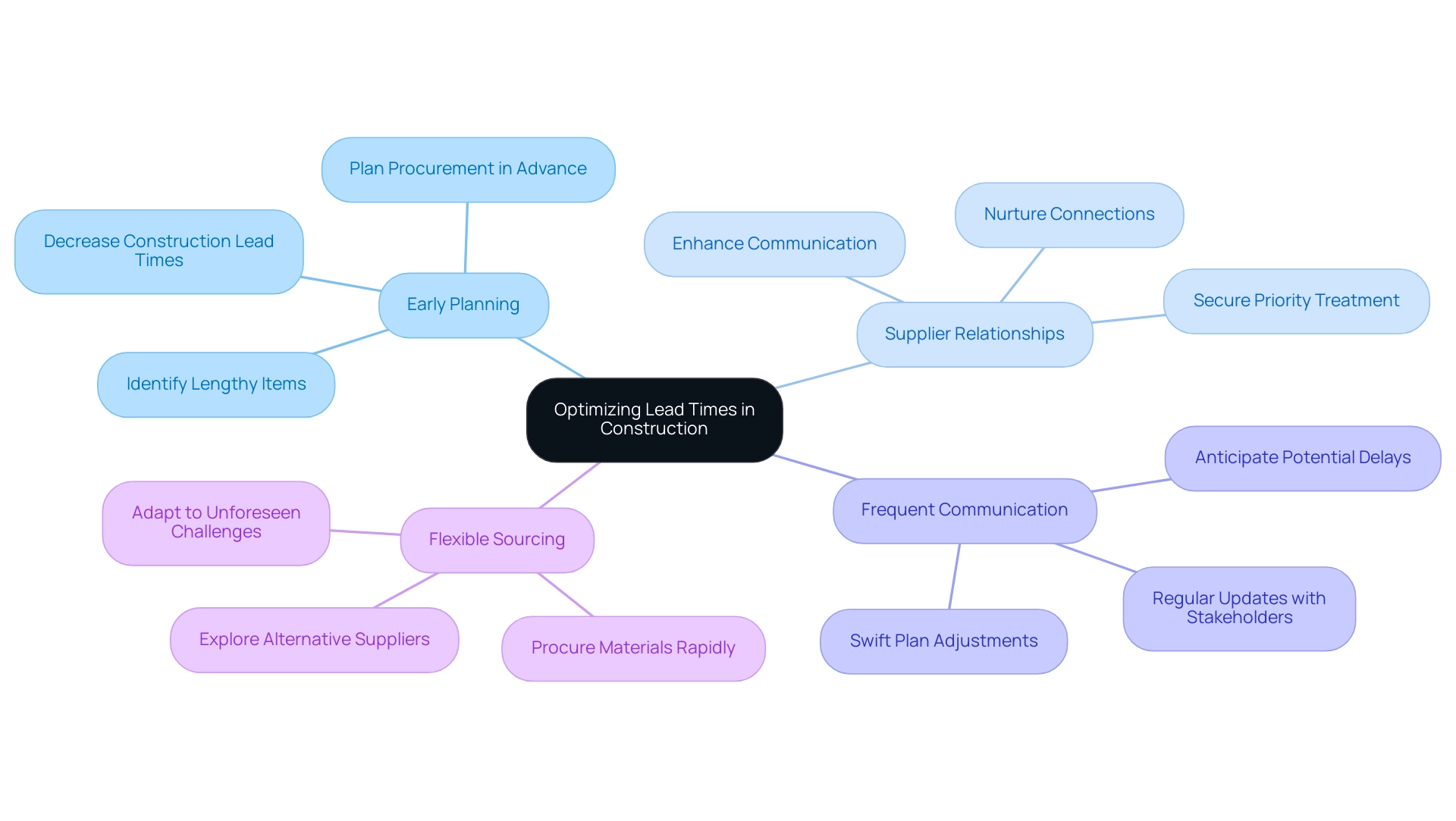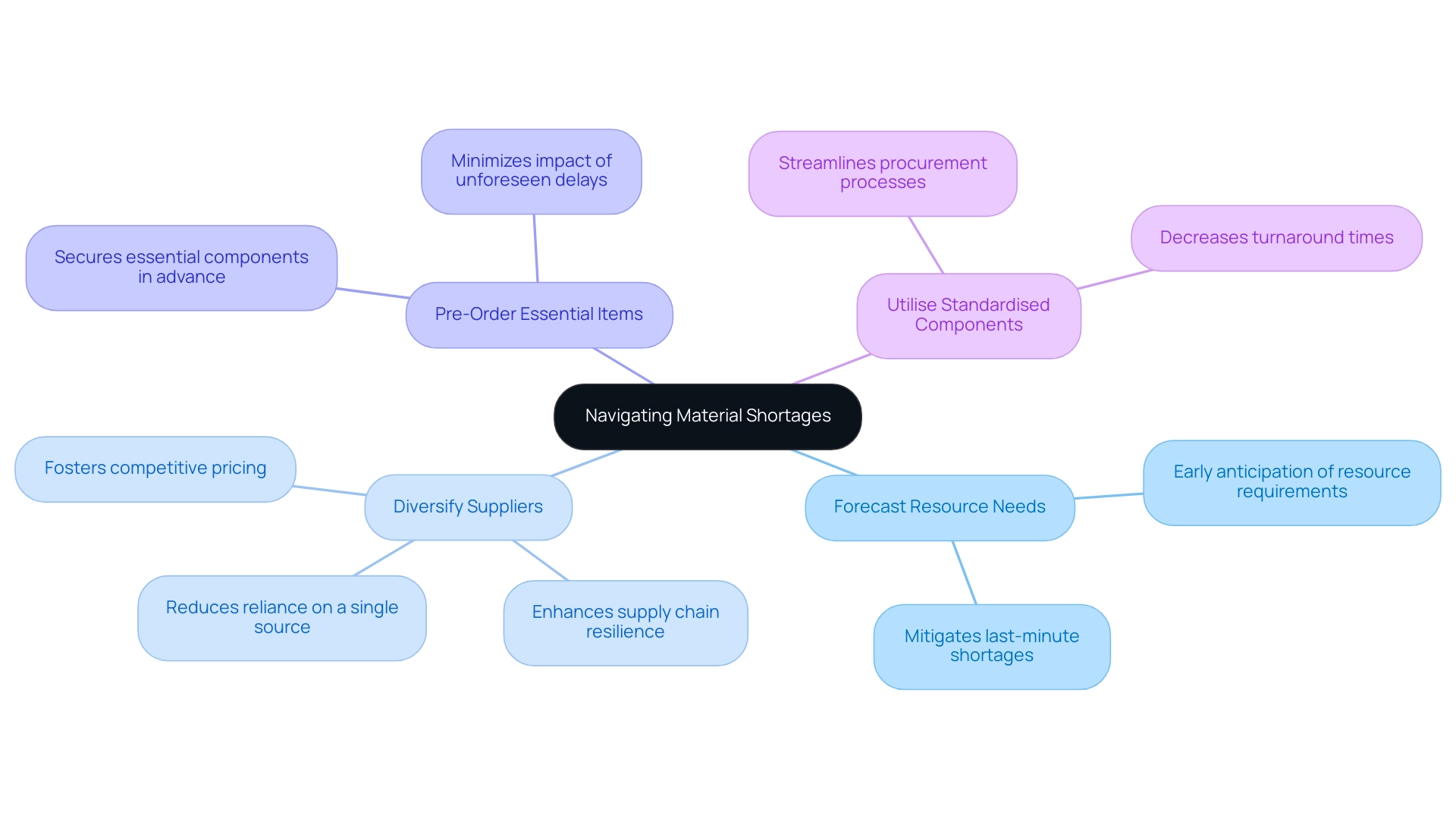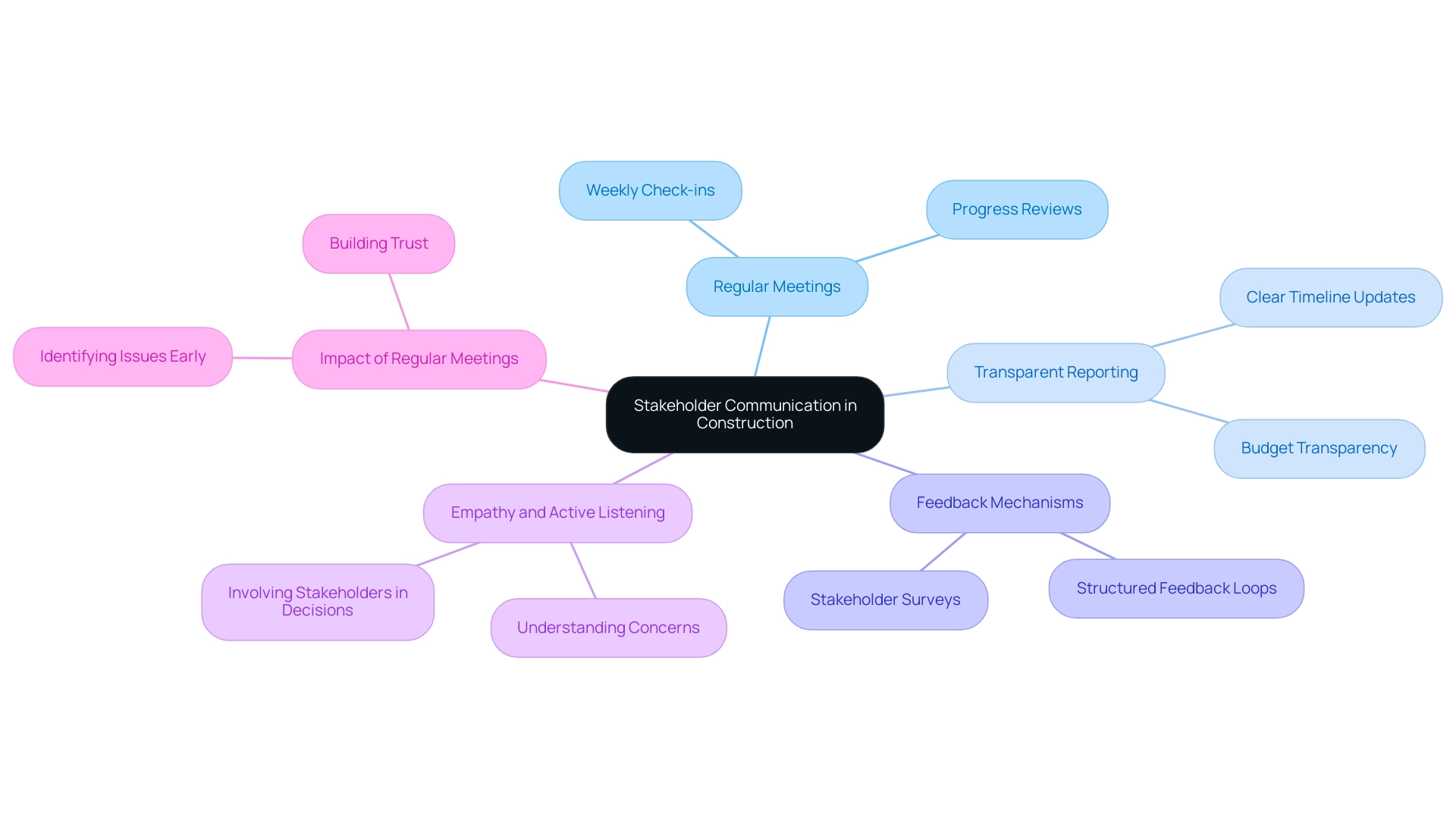27 Mar 2025
BlogOverview
To effectively reduce construction lead times, it is crucial to implement expert strategies such as:
- Early planning
- Cultivating strong supplier relationships
- Maintaining frequent communication
- Leveraging technology
These strategies not only streamline project efficiency but also mitigate delays, as illustrated by compelling case studies. These studies reveal that when proactive measures are adopted, projects experience improved outcomes and adherence to schedules. Therefore, embracing these strategies is essential for any construction professional aiming to enhance operational effectiveness and ensure timely project delivery.
Introduction
In the dynamic world of construction, lead times are not just logistical details; they are the backbone of effective project management and play a crucial role in determining the success of projects. These timelines, spanning from the inception of a project to the delivery of materials and task completion, are essential for maintaining project efficiency. Delays can lead to cost overruns, dissatisfied stakeholders, and missed opportunities. Therefore, it is imperative for project managers to understand and optimise these critical periods.
As the industry grapples with challenges such as material shortages, labour crises, and evolving technological landscapes, the ability to navigate lead times becomes even more vital. By embracing proactive strategies and leveraging innovative solutions, stakeholders can enhance project efficiency and ensure timely delivery. This approach not only sustains momentum but also positions projects for success in an ever-changing environment. Are you ready to take action and optimize your lead times to drive project success?
Understanding the Significance of Lead Times in Construction
Construction lead times represent the critical period from project initiation to the delivery of materials and the completion of tasks. These timelines are essential as they directly influence schedules, budgets, and resource management. When setbacks occur, they can lead to increased costs, task overruns, and stakeholder dissatisfaction. Therefore, it is imperative for managers and developers to grasp their significance.
Effective planning surrounding construction lead times is vital. It ensures that all necessary supplies and resources are available precisely when needed, thereby sustaining project momentum and financial viability.
In the hospitality sector, where timely project completion is often linked to seasonal demand, managing construction lead times becomes particularly crucial. For instance, a recent examination of building supply price indices revealed that as of January 2025, costs for supplies categorised under ‘All Work’ decreased by 0.9%, while ‘New Housing’ and ‘Repair and Maintenance’ saw a 1.0% increase. This fluctuation underscores the necessity of anticipating material availability and pricing trends to mitigate potential delays.
Edmond Shipway’s extensive expertise across multiple sectors, especially in hospitality, sport, and leisure, positions them well to navigate these challenges effectively. Their case studies demonstrate how tailored construction consultancy solutions have led to successful outcomes. For example, initiatives overseen by Edmond Shipway that adeptly managed their construction lead times reported a higher rate of on-time completion and adherence to budget constraints. Conversely, those that underestimated construction lead times encountered challenges, resulting in increased costs and extended timelines.
The Department for Business and Trade’s monthly indices of building supplies prices further emphasise this relationship, monitoring resource costs and their implications for budgeting. Expert insights reveal that understanding timelines can significantly enhance outcomes. It should be noted that while growth in building supplies prices has remained relatively stable, the potential for tariff increases could disrupt this equilibrium.
Such insights are essential for developers as they manage the complexities of material acquisition and scheduling.
As the building environment evolves in 2025, emphasising construction lead times will be crucial for ensuring success and maintaining a competitive edge in the hospitality sector. Additionally, anticipated infrastructure funding is expected to support nonresidential infrastructure initiatives, potentially impacting timelines and management strategies within this sector.

Proactive Strategies for Optimising Lead Times
To effectively optimise lead times in construction, project managers must implement several proactive strategies that are essential for success:
- Early Planning: Initiating the planning phase as early as possible is crucial. This approach allows teams to identify lengthy items and plan their procurement well in advance, thereby reducing potential delays. Statistics indicate that early planning can lead to a substantial decrease in construction lead times, underscoring its significance in successful project management.
- Supplier Relationships: Establishing strong relationships with suppliers is vital. By nurturing these connections, managers can secure priority treatment and enhance communication regarding resource availability. This is particularly important in an environment characterised by skilled labour shortages and regulatory pressures.
- Frequent Communication: Regular updates with all stakeholders are necessary to anticipate potential delays. This proactive communication enables teams to swiftly adjust plans, ensuring alignment and informed engagement throughout the project lifecycle.
- Flexible Sourcing: Exploring alternative suppliers or materials that can be procured more rapidly can significantly reduce construction lead times. This flexibility empowers managers to adapt to unforeseen challenges without compromising timelines.
Implementing these strategies not only streamlines project efficiency but also aligns with the growing emphasis on productivity within the building industry. As the UK construction sector enters a pivotal year in 2025, marked by promising investments and technological advancements, these strategies will be instrumental in overcoming challenges and seizing opportunities. Furthermore, the remarkable rise in UK green bond issuance by 77.7% from 2022 to 2024 emphasises the increasing focus on sustainability in construction, reinforcing the importance of early planning and proactive strategies in the context of sustainable practices.
AS noted by industry experts, “Every project we’re engaged in seems to be on an accelerated schedule.” This perspective underscores the critical role of data in managing accelerated schedules and optimising construction lead times. It’s imperative that project managers leverage good information to avoid poor decisions, ensuring effective execution in a rapidly evolving landscape.

Leveraging Technology to Enhance Construction Efficiency
Technology stands as a cornerstone of enhanced building efficiency, with tools such as Building Information Modelling (BIM), management software, and automated procurement systems revolutionising workflows and stakeholder communication. BIM, in particular, offers detailed visualisation of projects, enabling teams to proactively identify and address potential issues before they escalate into costly delays. This proactive strategy not only streamlines the construction process but also significantly reduces lead times.
The integration of cloud-based management platforms further amplifies efficiency by ensuring that all team members have access to real-time updates. This accessibility accelerates decision-making and minimises the risk of miscommunication, which can often derail initiatives. As the building sector faces rising costs, projected to increase by 1 to 3 percent annually—leveraging these technologies becomes vital for sustaining competitive advantage and managing project expenses.
Moreover, the current skilled labour shortage, underscores the urgency for building companies to adopt innovative solutions. This shortage emphasises the pressing need for firms to embrace technology to alleviate the impacts of labour mismatches and enhance overall productivity.
Case studies have shown that companies utilising BIM and other technological advancements experience significant improvements in construction lead times and cost management, reinforcing the effectiveness of these tools in today’s building landscape.
Looking ahead to 2025, the role of technology in building efficiency is set to expand. Predictions suggest that by 2025, we will witness rapid advancements in an industry that has historically lagged in technological adoption, as it strives to make up for lost ground and embark on its digital revolution. The industry’s transition to digital solutions is not merely a trend; it is a necessary evolution to address the demands of contemporary building challenges.
By prioritising technological integration, companies can enhance their operational efficiency, reduce turnaround times, and ultimately deliver outcomes that meet the high standards expected in the hospitality industry and beyond.
Navigating Material Shortages and Their Impact on Lead Times
Material shortages have increasingly troubled the building sector, leading to delays in work and extended construction lead times. In 2025, these challenges are anticipated to worsen, with ongoing supply chain disruptions and increasing demand for construction resources. To effectively navigate these obstacles, project managers can adopt several strategic approaches:
- Forecast Resource Needs: Early anticipation of resource requirements is crucial. By conducting thorough assessments at the project’s outset, teams can mitigate the risk of last-minute shortages that can derail timelines.
- Diversify Suppliers: Establishing relationships with multiple suppliers is essential to reduce reliance on a single source. This strategy not only enhances supply chain resilience but also fosters competitive pricing and availability.
- Pre-Order Essential Items: For supplies recognised to have prolonged delivery times, proactive pre-ordering can be a game changer. This approach ensures that essential components are secured well in advance, which helps minimise the impact of unforeseen delays on construction lead times.
- Utilise Standardised Components: Standardising resources can streamline procurement processes and significantly decrease turnaround times. By adopting common specifications, building teams can simplify sourcing and enhance efficiency.
Recent statistics highlight the effect of supply shortages on construction lead times, demonstrating a growing focus on sustainability and efficient resource management in development endeavours. As stakeholders increasingly assess contractors based on their environmental, social, and governance (ESG) performance, the pressure to innovate and adapt becomes paramount. This trend emphasises the significance of incorporating sustainable practices into management strategies, especially in light of resource shortages.
Edmond Shipway’s consultancy services can play a pivotal role in addressing these challenges. By utilising our knowledge in management and cost efficiency, we help clients in predicting resource requirements and diversifying their supplier network. Case studies illustrate the effectiveness of these strategies.
For instance, a recent project faced significant delays due to a shortage of steel. By diversifying their supplier base and pre-ordering essential resources, the team was able to reduce construction lead times and finish the project on schedule, showcasing the significance of proactive planning in addressing resource shortages. Additionally, infrastructure investments are anticipated to aid nonresidential infrastructure initiatives, offering further context on the wider economic factors affecting resource availability and timeline schedules.
In summary, by applying these strategies and embracing sustainability, building teams can better manage the risks related to material shortages, ensuring smoother execution and improved overall performance.

The Role of Stakeholder Communication in Reducing Lead Times
Effective stakeholder communication is paramount for minimising construction lead times in construction endeavours. By maintaining regular updates and fostering open lines of communication, all parties can stay informed about status, potential challenges, and any changes to timelines.
Key Strategies to Enhance Communication:
- Regular Meetings: Establish consistent meetings with all stakeholders to review progress and address any concerns. This practice not only keeps everyone aligned but also builds trust among team members.
- Transparent Reporting: Utilise management tools to offer clear and accessible reporting on timelines, budgets, and resource allocation. Transparency in these areas helps stakeholders understand the project’s trajectory and facilitates informed decision-making.
- Feedback Mechanisms: Create structured feedback loops to solicit input from all stakeholders. This approach facilitates quick modifications to plans, ensuring that the project remains on track and responsive to stakeholder needs.
- Empathy and Active Listening: Engaging with stakeholders requires empathy and active listening to understand their concerns fully. Involving them in decision-making processes can significantly enhance their commitment to the project.
- Impact of Regular Meetings: Research indicates that regular meetings can positively influence timelines, as they provide opportunities to identify and resolve issues before they escalate. The significance of effective communication is emphasised by findings that highlight how stakeholder engagement directly correlates with success.
This emphasises the need for ongoing dialogue and engagement to navigate complexities effectively. Furthermore, a study discovered that stakeholders who believe their feedback is appreciated are twice as likely to stay involved during a project. Moreover, the development of a large-scale infrastructure projects involve extensive stakeholder engagement, showcasing the relevance of effective communication strategies in real-world scenarios.
By fostering a culture of open communication, teams can significantly reduce the risk of delays, which can improve construction lead times and enhance overall efficiency, ultimately leading to successful outcomes.

Identifying and Overcoming Common Challenges in Construction
Common challenges in building that can lead to delays are significant and multifaceted.
- Labour Shortages pose a critical issue; the building sector is currently grappling with substantial labour shortages, with projections indicating that the global workforce will expand from 220 million in 2020 to 300 million by 2030. This shortage can severely hinder project progress. To address these issues, investing in training programmes and forming partnerships with local trade schools is essential to cultivate a skilled workforce.
- Regulatory Delays also contribute to project setbacks. Navigating the complexities of permits and inspections often results in time-consuming delays. Engaging with local authorities early in the initiative lifecycle can streamline these processes, thereby reducing the likelihood of regulatory holdups.
- Additionally, Weather Conditions can disrupt construction schedules. To mitigate this risk, it is prudent to incorporate buffer time into timelines, allowing for potential weather-related interruptions.
- Supply Chain Disruptions present another challenge, as worldwide occurrences can lead to resource shortages, affecting timelines. Maintaining flexibility in sourcing materials and considering alternative options can help alleviate these disruptions.
By proactively identifying these challenges and implementing strategic solutions, project managers can significantly minimise their impact on construction lead times.
Conclusion
Lead times in construction stand as a critical determinant of a project’s success or failure. Recognising their significance empowers project managers to adeptly navigate complexities, ensuring timely delivery and strict adherence to budgets. The article underscores that proactive strategies, such as early planning, nurturing supplier relationships, and leveraging technology—are essential for optimizing lead times. By implementing these tactics, construction teams can markedly enhance project efficiency and mitigate the risks tied to delays.
Furthermore, as the industry grapples with challenges like material shortages and labor crises, the necessity for robust stakeholder communication cannot be overstated. Engaging all parties through regular updates and transparent reporting fosters a collaborative environment capable of preemptively addressing potential issues. The integration of innovative technologies, such as Building Information Modeling (BIM) and cloud-based platforms, further bolsters this communication, streamlining workflows and enhancing decision-making.
As the construction landscape evolves, particularly within the hospitality sector, the capacity to adapt and embrace proactive measures will be paramount. The growing emphasis on sustainability and efficient resource management increasingly shapes project management strategies, underscoring the need for firms to remain ahead of market trends. By prioritizing lead time optimization, construction professionals not only safeguard their projects’ timelines and budgets but also position themselves for success in an increasingly competitive environment. The call to action is unequivocal: embracing these strategies now will lay the groundwork for more resilient and efficient construction practices in the future.
Share

